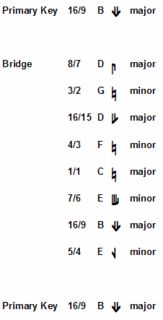Listen here:

Subscribe here: 
Liner Notes
"For the Downwinders" is based on a scale derived from the ratios of the otonality, starting at 10. Another way to think of it is the rations of 10:11:12:13:14:15:16:18:20. This mode gives me a minor feel when I stress the triad E G B.
I started this off when
Christopher Bailey talked about trying to compose something for his least favorite chord, the C-G-C# triad. He asked if there is a tuning that could be based on this, and several microtonal theoreticians came up with some ideas. I explored how the Partch Tonality Diamond, taken to the 15 limit, has many instances that approach this triad.
For example, the following three notes chords are variations on his triad:
Ratio - Note names & ratios
9: 14:20 - D 9/8 - B 7/4 - E 5/4
10:15:22 - E 5/4 - B 15/8 - F 11/8
11:16:24 - F 11/8 - C 1/1 - G 3/2
12:18:26 - G 3/2 - D 9/8 - A 13/8
13:20:28 - A 13/8 - E 5/4 - B 7/4
14:22:32 - B 7/4 - F 11/8 - C 1/1
15:22:32 - B 15/8 - F 11/8 - C 1/1
8: 12:18 - C 1/1 - G 3/2 - D 9/8
They all have a different feel, but they all include close approximations of the chord.
The title is taken from the recent trial in Spokane, WA, in which those who lived downwind of the Hanford Nuclear Reservation and sought compensation for thyroid cancer. They won a Phyrric victory, when the damages awarded were far smaller than their legal costs.
Starting in 1944, the Hanford Reservation in central Washington produced Plutonium for nuclear weapons, including producing the components for the legendary "Big Boy" atomic bomb that was dropped on Nagasaki on August 9, 1945, to hasten the surrender of the Japanese and end World War II. It continued to do this for many years to support the cold war arms race.
Because of the war-time rush, the Hanford plutonium plants processed the irradiated fuel without allowing the radioactivity enough time to decay. For still unknown reasons, Hanford kept processing this very radioactive fuel even after Japan surrendered. As a result, vast quantities of pollution, especially iodine-131, were discharged into the air. In 1945 alone, more than a half million curies of Iodine-131 were released. The accident at Three Mile Island was estimated to have released about 20 curies. People were exposed to the airborne radiation by breathing the air and consuming certain foods, especially milk from goats or cows that grazed on contaminated vegetation.
Those who lived "downwind" of the plant have been seeking compensation for their losses, including cancers and related injuries. Those who claim harm have taken their case to court, and won a partial victory. They won several counts, but their monetary damages were far less than their legal costs.
I have enormous sympathy for the victims of this tragedy. The contractors were caught between their drive to quickly produce components for a weapon that could end the war and save the thousands of lives that an invasion of the island of Japan would cause, and safety. Safety lost.
Prent Rodgers

